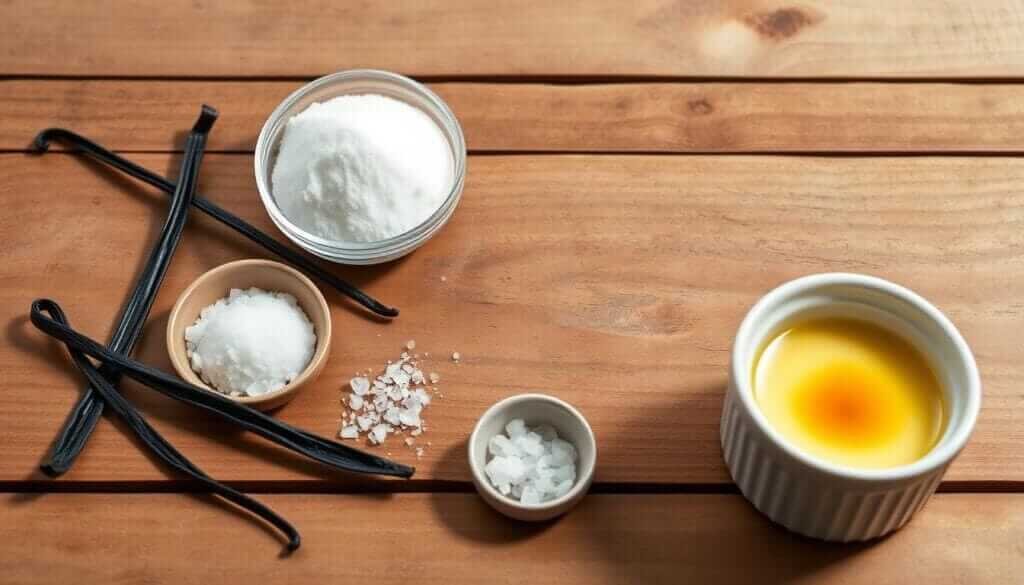Creme brulee is a classic French dessert loved for its smooth custard and caramelized sugar. It’s naturally gluten-free, making it great for those with gluten issues. If you’re wondering, is creme brulee gluten free?, the answer is yes! We’ll look into its ingredients and how it’s made to confirm its gluten-free status.

Key Takeaways
- Creme brulee is a naturally gluten-free French dessert made with just four simple ingredients: heavy cream, egg yolks, sugar, and vanilla.
- The custard-based nature of creme brulee, without the inclusion of any wheat-based flours or grains, ensures it is a safe option for those following a gluten-free diet.
- Creme brulee’s popularity and versatility make it a desirable dessert choice, with options for both traditional and innovative flavor combinations.
- Proper technique and equipment are essential for achieving the signature smooth texture and caramelized topping of creme brulee.
- Dietary variations and alternatives exist to accommodate different dietary needs and preferences, ensuring creme brulee can be enjoyed by a wide range of consumers.
Understanding Creme Brulee: A Classic French Dessert
Crème brûlée is a French custard dessert loved by many. It has a caramelized sugar topping that shows the beauty of French cuisine.
The Origins of Crème Brûlée
The history of crème brûlée goes back to the late 17th century in France. Its creator is unknown, but it’s a key part of French cooking. It has grown from a simple custard to a fancy dessert in top restaurants.
Traditional Recipe Components
The basic ingredients of crème brûlée are egg yolks, heavy cream, vanilla, and sugar. The custard is baked until smooth. Then, the top is caramelized for a nice contrast.
Cultural Significance
Crème brûlée is very important in French cooking. It shows France’s love for food. It’s loved all over the world, known for its simplicity and elegance.
“Crème brûlée is the ultimate expression of the French pastry chef’s art – a baked custard with a caramelized sugar topping that shatters with the first bite.”
Is Creme Brulee Gluten Free?
Creme brulee is a standout among gluten-free desserts. This classic French treat is naturally gluten-free. Its main ingredients – heavy cream, egg yolks, sugar, and vanilla – don’t have gluten. This makes it perfect for those with dietary restrictions like celiac disease or gluten sensitivity.
The dessert’s base is a creamy custard that’s baked until it’s set. Then, the top gets caramelized, adding a nice contrast of textures and tastes. None of the usual creme brulee ingredients have gluten, so it’s safe for gluten-free diets.
But, always check the recipe or ask the restaurant to make sure there’s no gluten added. Also, be aware of cross-contamination risks. It’s smart to ask about the kitchen’s gluten-free practices when eating out.
For a delicious and gluten-free dessert option, creme brulee is a great pick. Its creamy, rich taste is enjoyable for everyone, making it a favorite for those with dietary needs.

“Creme brulee is a dessert that transcends dietary restrictions, offering a decadent experience that anyone can savor.”
Essential Ingredients for Making Creme Brulee
Making the perfect creme brulee needs a few key ingredients. These are heavy cream, egg yolks, sugar, and vanilla bean paste. Together, they make this French dessert creamy and decadent.
Core Components Analysis
Heavy cream gives creme brulee its rich, velvety texture. Choose high-quality, fresh heavy cream with at least 36% fat for the best taste. Egg yolks make the custard smooth and creamy, binding the ingredients together.
Sugar sweetens the custard and creates the caramelized topping. You can use white sugar or try other sugars like caster or brown sugar for different flavors.
Vanilla bean paste adds a deep vanilla flavor. You can also use vanilla extract or a whole vanilla bean for flavor.
Quality Considerations
The quality of your ingredients is crucial for creme brulee. Choose the freshest, highest-quality heavy cream, eggs, sugar, and vanilla. This ensures a rich, creamy texture and a balanced flavor.
Ingredient Substitutions
You can try different substitutions for creme brulee. For a gluten-free version, use cornstarch or rice flour instead of flour. Honey or maple syrup can replace sugar, and vanilla extract or whole vanilla beans can substitute vanilla bean paste.
| Ingredient | Substitution |
|---|---|
| Heavy Cream | Coconut Cream |
| Egg Yolks | Aquafaba (Chickpea Liquid) |
| Sugar | Honey, Maple Syrup |
| Vanilla Bean Paste | Vanilla Extract, Whole Vanilla Bean |

“The key to a perfect creme brulee is using the highest-quality ingredients and paying close attention to the details throughout the preparation process.”
The Science Behind Creme Brulee’s Texture
The silky-smooth texture of creme brulee comes from the custard base. Egg yolks and heavy cream mix to create a rich, creamy base. It’s baked in a water bath, or bain-marie, to avoid curdling.
The caramelized sugar topping is a result of a chemical reaction. When sugar heats up, it caramelizes, turning into a crisp, glassy layer. This mix of smooth custard and crunchy caramel makes creme brulee special.
Heavy cream with a high fat content, around 36%, is key for the custard’s custard consistency. Egg yolks, added at room temperature, add to the luxurious feel. Baked at 150°C (302°F) for about 45 minutes, the custard sets perfectly, ready for chilling and caramelizing.
“The creamy custard needs to chill in the fridge for 4-5 hours to set fully before caramelizing the sugar on top.”
The right mix of ingredients and techniques gives creme brulee its famous custard consistency and caramelization. This balance between creamy custard and crunchy sugar topping is what makes it a treat for the senses.

Tools and Equipment for Perfect Creme Brulee
Making the perfect crème brûlée needs a few key tools. You’ll need ramekins for the custard and a kitchen torch for the sugar topping. Each tool is important for the dessert’s texture and look.
Essential Kitchen Equipment
- Ramekins: Pick deep ramekins, about 90 ml, for a thicker custard layer.
- Roasting Pan: A roasting pan or baking dish is needed for a water bath (bain-marie) to cook the custard evenly.
- Kitchen Torch: A kitchen torch lets you control the sugar topping’s caramelization, adding a nice crunch.
- Whisk and Saucepan: A whisk and a heavy-bottomed saucepan are key for blending and cooking the custard mixture.
Torch vs. Broiler Method
A broiler can caramelize sugar, but a kitchen torch is better. It gives precise heat, caramelizing sugar evenly without burning the custard. This way, you get a crunchy topping with every bite.
Ramekin Selection Guide
The ramekin’s depth affects your crème brûlée’s texture and look. Deeper ramekins (around 90 ml) give a thicker custard layer. Shallower ramekins mean more caramelized sugar topping. Choose based on your preference and serving size.
“The key to a perfect crème brûlée is in the balance between the silky smooth custard and the satisfying crunch of the caramelized sugar topping.”
Step-by-Step Preparation Guide
Making the perfect crème brûlée recipe is a fun journey. Start by mixing egg yolks, sugar, and vanilla until it’s smooth. Then, add heavy cream slowly while whisking until everything is well mixed.
Next, fill individual ramekins with the custard mixture and place them in a water bath. Bake at 350°F for 30-45 minutes. The edges should be set, and the centers slightly jiggly. This step is key for a great creme brulee dessert preparation.
- Whisk egg yolks, sugar, and vanilla until smooth.
- Slowly add heavy cream, mixing well.
- Pour the custard into ramekins in a water bath.
- Bake at 350°F for 30-45 minutes until the edges are set.
- Chill the custards for 3-4 hours or up to 48 hours.
- Sprinkle 1-1½ teaspoons of sugar evenly over the tops.
- Caramelize the sugar using a kitchen torch or broiler.
- Serve the crème brûlée immediately for best results.
After baking, chill the custards for at least 3-4 hours, or up to 48 hours. This step is crucial for the right baking technique and texture. Just before serving, sprinkle 1-1½ teaspoons of sugar over the chilled custards. Use a kitchen torch or broiler to caramelize the sugar until it’s golden and crisp.
“The success of the dessert lies in tempering the cream into the egg mixture slowly to avoid scrambling.”
Serve the crème brûlée right away. The caramelized topping is best when it’s still warm and crisp. With these steps, you can make a restaurant-quality crème brûlée recipe at home.
Common Mistakes to Avoid When Making Creme Brulee
Making the perfect creme brulee is an art. It’s important to avoid common mistakes to get that creamy custard and caramelized sugar. Issues like temperature control, custard consistency, and caramelization can ruin your dessert. Here are some tips to help you avoid these problems.
Temperature Control Issues
Temperature is key when making creme brulee. If the custard is too hot, it becomes grainy. If it’s too cold, it’s runny. Use a water bath and keep an eye on the temperature.
Custard Consistency Problems
The custard texture is crucial. If it’s too thick, it’s dense. If it’s too thin, it’s not smooth. Watch the custard while it bakes and chill it well before caramelizing.
Caramelization Challenges
The caramelized sugar topping is the best part. But it can be hard to get right. Make sure the sugar is evenly spread and use gentle heat to avoid burning. Chilling the custard before caramelizing is key for the right texture.
Mastering these common mistakes will help you make amazing creme brulee. With practice and these tips, your desserts will impress everyone at dinner parties.
Dietary Variations and Alternatives
The traditional crème brûlée is naturally gluten-free. But, there are many other options for different tastes and needs. For those who don’t eat dairy, coconut cream or plant-based creams can replace heavy cream. Vegan recipes use silken tofu or cornstarch to get a creamy texture without eggs.
There are countless flavors to try, like chocolate, lemon berry, chai, and maple. These changes let you enjoy crème brûlée while meeting your dietary needs. This includes vegan, lactose-free, or gluten-free diets.
Vegan Crème Brûlée
Vegan desserts, including crème brûlée, are becoming more popular. They appeal to vegans and those who want a cholesterol-free treat. Vegan crème brûlée uses coconut milk, cornstarch, agar powder, and plant-based milks like almond or soy.
To make vegan crème brûlée, you mix these ingredients to thicken the custard. This makes a smooth, creamy texture like the traditional version. But, it’s key to dissolve the agar powder fully and not overheat the mixture.
| Ingredient | Quantity | Nutritional Information (per serving) |
|---|---|---|
| Coconut Milk | 1 cup | Calories: 445, Fat: 48g, Carbs: 12g, Protein: 5g |
| Cornstarch | 2 tablespoons | Calories: 60, Fat: 0g, Carbs: 14g, Protein: 0g |
| Agar Powder | 1 teaspoon | Calories: 6, Fat: 0g, Carbs: 1g, Protein: 0g |
| Almond Milk | 1/2 cup | Calories: 30, Fat: 2.5g, Carbs: 1g, Protein: 1g |
Vegan crème brûlée keeps well in the fridge for up to 3 days. It’s a tasty, dairy-free option. With so many flavors, from vanilla to chocolate, it’s a delightful French classic for everyone.
“The possibilities for utilizing leftover egg whites include making omelets, tortillas, meringues, or even creating play slime for kids.”
Conclusion
Crème brûlée is a classic French dessert that’s easy to make gluten-free. The main ingredients like heavy cream, eggs, and vanilla don’t have gluten. This means you can enjoy it even if you’re gluten-sensitive, without losing any flavor or texture.
With the right techniques and top-notch ingredients, you can make a gluten-free crème brûlée that wows your guests. It’s perfect for satisfying your cravings for French desserts.
Learning about the dessert’s smooth custard and caramelized top is key. Try different gluten-free flours and sugars to get it just right. Crème brûlée is great for any occasion, whether it’s a dinner party or a special treat for yourself.
As you dive into more gluten-free desserts and French cuisine, remember the importance of quality ingredients. Also, don’t forget the dedication needed to master crème brûlée. With practice and patience, you’ll create a dessert that’s as elegant as it is delicious.
Conclusion:
Crème brûlée is a naturally gluten-free dessert, making it a safe and indulgent choice for those with gluten sensitivities or celiac disease. Its simple, high-quality ingredients—heavy cream, egg yolks, sugar, and vanilla—ensure it remains free from gluten while delivering its signature creamy custard and caramelized sugar crust. Whether you’re enjoying a classic version or exploring dairy-free or vegan alternatives, crème brûlée offers a versatile and delicious option for everyone. For more information on gluten-free diets and dessert options, check out resources from the Celiac Disease Foundation or explore culinary insights from Harvard T.H. Chan School of Public Health. Indulge in this timeless French dessert with confidence, knowing it fits seamlessly into a gluten-free lifestyle!
FAQ
Is creme brulee gluten-free?
Yes, creme brulee is naturally gluten-free. It’s made with ingredients like heavy cream, egg yolks, sugar, and vanilla. These don’t have gluten.
What are the core ingredients in creme brulee?
Creme brulee’s main ingredients are heavy cream, egg yolks, sugar, and vanilla. Using fresh, high-quality ingredients is key for the best taste.
Can creme brulee be made dairy-free or vegan?
Yes, creme brulee can be made without dairy. You can use coconut cream or silken tofu instead. This way, it’s still delicious but fits different diets.
What tools are essential for making creme brulee?
You’ll need ramekins, a kitchen torch or broiler, and a roasting pan for the water bath. Ramekins decide the custard’s thickness. The torch or broiler caramelizes the sugar on top.
What are the common mistakes to avoid when making creme brulee?
Avoid overcooking the custard to prevent a grainy texture. Also, don’t undercook it to avoid a runny mess. Keeping the temperature right is key. A water bath helps a lot.
For the caramelized top, make sure the sugar is evenly spread. Use controlled heat to avoid burning it.


